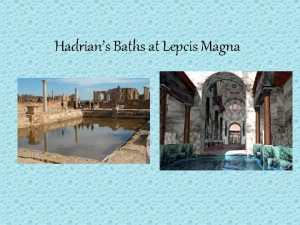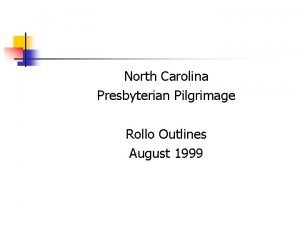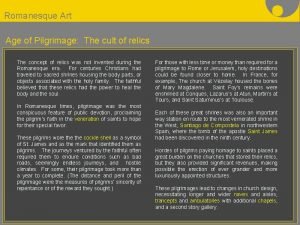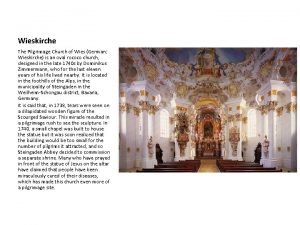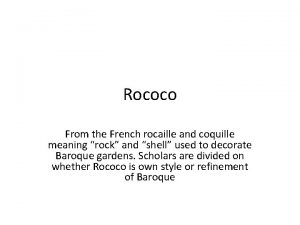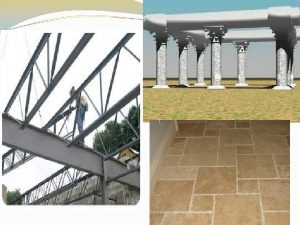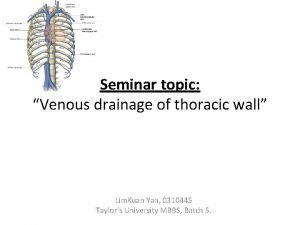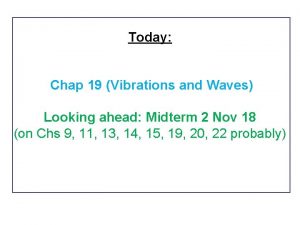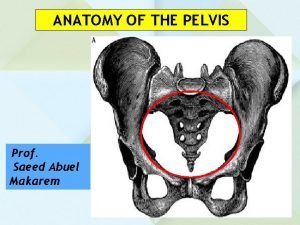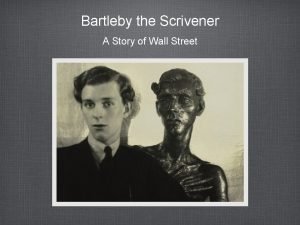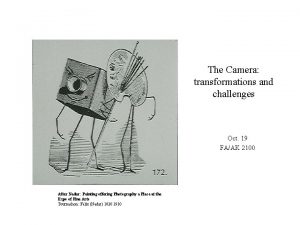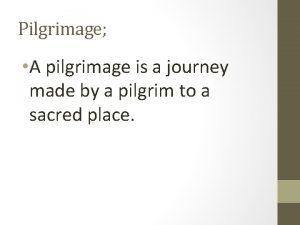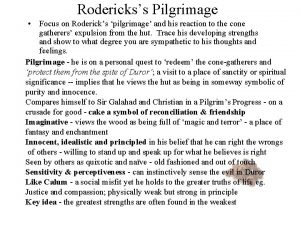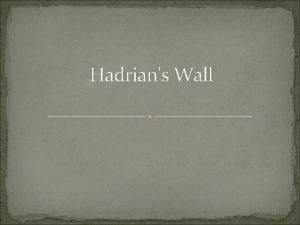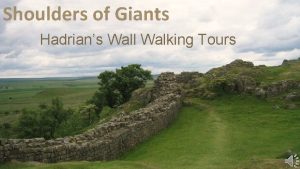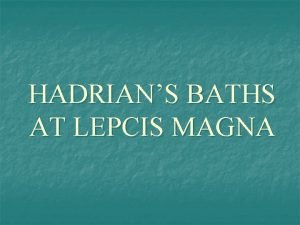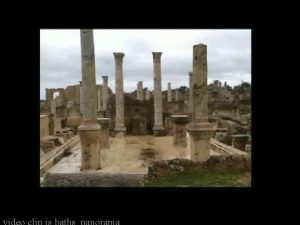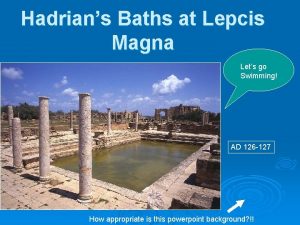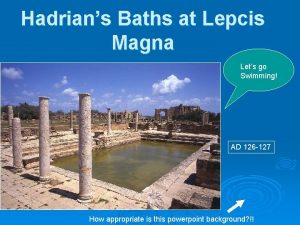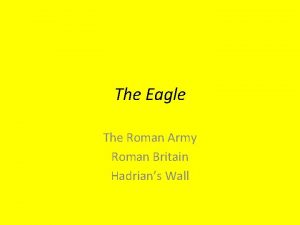The Wall The Hadrians Pilgrimage 2019 20 th
















































































- Slides: 80

The Wall The. Hadrian’s Pilgrimage, 2019 20 th – 27 th July 2019

My Fifth Pilgrimage The Pilgrimage of Hadrian's wall is a venerable institution. The first took place in 1849, and they have taken place every 10 years, gine and take a few intervals. This was my fifth pilgrimage. My first was in 1969, which I reported in CA 15. I then missed out on the 1979 pilgrimage, but I went on the 1989 pilgrimage (CA 116), the 1999 Pilgrimage (CA 164) and the 2009 Pilgrimage (CA 240). I wanted to do one last pilgrimage. There was however a problem. I am now 82, and my walking has deteriorated badly - I can’t really walk more than a couple of hundred yards at a time. Indeed on the Thursday my knees collapsed when I was getting onto the coach and I gnashed my shin - I am still suffering from it. Nevertheless, even if I could not do any of the long walks, I could still go round the all the forts and the museums, or even walk short stretches: and I was able to meet many old friends and see the Wall for one last time. Here then is my report of the 14 th pilgrimage – my fifth and last.

We began in the slightly faded splendours of the Royal Station Hotel, Newcastle. It was conveniently situated a hundred yards from the station and was redolent of the glories of the age of steam. We stayed here for four days before moving on to the County hotel at Carlisle.

At the opening dinner I found I was not the only pilgrim wearing a bow tie. I was joined by Sebastian Sommer, the chief archaeologist of Bavaria and the guru of the Roman system in Germany.

Benwell

Our first stop was at Benwell, the first fort west out of Newcastle. The actual fort is covered by the modern housing estate seen in the photo and the only preserved part is the totally anomalous feature that is the defended gateway over the vallum. The vallum is still one of the great mysteries of Hadrian’s Wall, a flat bottomed ditch with banks on either side running up to a mile south of the actual wall. Its purpose remains a mystery — it is still tempting to see it as some sort of customs barrier. At Benwell the vallum runs a hundred yards south of the Fort, but uniquely there is a crossing over the vallum with an elaborate Gateway. The flat bottomed ditch can be seen in the photo above, while below is the English Heritage reconstruction drawing. Note the actual Fort in the background.


We continued with our study of the vallum by visiting a section that is virtually unknown in Denton Burn. Here the developers were persuaded to leave a section of the vallum intact and here we see David Breeze, the chief pilgrim explaining the vallum with great enthusiasm – Tony Wilmott is in the background. It is rather odd having this somewhat unkempt field in the middle of suburbia, but at least we visited it. We then walked back to the wall itself, seen here alongside the A 69, the main road to the West, with traffic thundering past on the dual carriageway



The next visit was the turret 26 b, at Brunton and here you see me demonstrating that I can still get over a stile - with some difficulty. Turret 26 B is terribly important for wall studies because this is where the Broad wall is replaced by the narrow wall. Hadrian's Wall was originally intended to be 12(? ) feet wide, but when they reached turret 26 B they decided to narrow it to 10 feet wide. However, the turrets had already been built by a different squad of turret builders, and here you can see the projecting stub at the original broad gauge linking to the narrow gauge.


Chesters We then went on to Chesters which is the first major fort, west of Newcastle laid out for inspection. It is perhaps the nicest of all the forts with the River South Tyne running alongside. But it in the 19 th century it was the home of John Clayton, the wealthy Newcastle solicitor who decided to buy up as much of Hadrian's wall as he could in order to preserve it and eventually ended up the owner of four forts and a long stretch of the wall which today is one of the best stretches of the wall. He built a special museum for the sculptures he found on his property. This has recently been restored by English Heritage, following a long discussion whether it should be modernised or restored as a Victorian museum, but it has been restored as Clayton left it: the results is a triumph.

The barrack blocks at Chesters

The Chesters museum

The bath house at Chesters, with the river South Tyne in the background. Note centre bottom the stoke hole for the hot room.

The tepid room in the Chesters bathhouse. Note the window in the far end, one of the few windows to survive from a bathhouse

The Great North Museum In the evening we visited the Great North Museum at Newcastle. This was originally the Hancock Museum of Natural History, but in 2009 it was combined with the University Museum of Antiquities and Brian Shefton’s collection of Greek sculpture to form the Great North Museum. The result is highly controversial. The worst exhibit can be seen overleaf: the Museum of Antiquities had a superb model of the course of Hadrian's wall, which was ripped out and replaced with this totally uninformative travesty. We then show a good example of the criticisms aimed at the new Museum: a Roman altar and its caption. The text accompanying the altar is not in fact a translation of the text, but a very misleading paraphrase: the detail is very speculative while the tone is far too cynical and probably wrong. Any schoolchild reading it would will be totally misled about the nature of the Roman Empire.

Above: The Hancock (now Great North) museum. Right: the model of Hadrian’s Wall. The only other feature shown is the river Tyne

The altar actually reads: To the goddess Minerva and the Genius of ? ? Caecilius Optatus performed his vows Matt Symonds explains a milecastle to some of the pilgrims.

Housesteads is the most majestic of the Hadrian's wall forts. It is the highest, the most bleak, but with stunning views, and with the wall stretching away on both sides. When we got there it was blowing a gale and we could scarcely stand up. Luckily, Lindsay Alison Jones took me in her car up to the Museum – she knows the secret way up, and then I managed to see the fort. The idea was that we would climb up to the top of the ridge and then walk westwards to see the next milecastle, but having staggered to the top with considerable help, I then saw the pilgrims marching off into the distance and I knew I could not follow them. I decided to explore the Fort, but curses! the West gate was blocked by English Heritage, so that you had to go round to the South gate – and pay!

Below. The statue of Victory in the Housesteads museum, set against a fine photo of the best stretch of Hadrian's wall. Museums tend to forget about the background to the objects on display, but here English heritage got it right! Top right. The pilgrims disappearing into the distance. Right below, The West gate, blocked to make you go round and pay!

A stitched together photo looking south from the fort. In the foreground, Tim Tatton Brown is defying the gale and consulting his computer in the Commandant's house. Note the clump of trees half right, which shelters the farm and Museum. When Clayton bought the Fort, there was a farmhouse sheltering in the inside the fort: see painting right, now in Chesters Museum. He therefore moved the farmer out and built a new house for him, now the Museum

David Breeze demonstrates the most mysterious aspect of Housesteads. It appears the wall was originally built without forts, but when it was decided to move the forts up onto the wall, it was decided that the Housesteads fort should project north of the wall. When Richmond was excavating in the 1950 s he found traces of the original wall where David is pointing to it

The North gate of Housesteads, facing the Barbarians. It appears to face out onto a steep drop, but there was a ramp leading up to it that was removed in the 19 th century to make it more dramatic. But note Hadrian's Wall snaking away into the clump of trees, top right.

South Shields and Wallsend The next day we went back to do the east end of the wall, that is east of Newcastle, where there are two splendid forts at South Shields and Wallsend. South Shields is not strictly a wall fort, but a supply depot situated 5 miles South of the Wall. It was originally excavated in the 19 th century as the Roman Remains Park, and it now has some splendid reconstructions. Wallsend is north of the Tyne, and as name suggests, is the end of the Wall. It was originally covered by the houses of the workers of the Swan Hunter shipyard, but in the 1970 s the shipyards declined so the whole area was cleared and the fort was excavated.


The first and still the latest magnificent of the reconstructions at our buyer has been that of the Gateway. This was highly controversial at the time because the British tradition does not allow of reconstruction on site, – though the German tradition dollars budget has been a great success. The more recently constructions is of the Tribune's house in the South West corner of the Fort and adjacent to it a barrack block by contrast at the barren. In the late Roman period, the commanding officer, a Tribune built a new house for himself in the corner of the Fort set out according to the best Mediterranean traditions and half of this has been reconstructed. The most impressive part is the dining room where the position of or tricking them where the position of the couches could be seeing in the excavation




Two famous tombstones from South Shields. Left is that of Regina (=Queenie? ) freedwoman and wife of Barates a Palmyran, though she was by nation a Catuvellaunian (= from St Albans). She died aged 30. What is fascinating is that underneath there is a line of an Aramaic inscription reading Regina, freedwoman of Barates, alas. Top right is the tombstone of Victor, a Moor from North Africa, , who was the freedman of Numerianus, a cavalryman. He died aged 20


Wallsend

Looking across the archaeological Park at Wallsend. On the far side is the Museum and its observation tower from which the excavations can be viewed. In the distance on the right is the River Tyne, where once the steamship Mauritania was built in the Swan Hunter ship yards. A short wall ran from the Fort down to the Tyne to mark the end of the Wall

The newly excavated Roman bathhouse that had been hidden under a pub down by the river

Ten years ago this stretch of the Roman Wall was uncovered and a full-height replica was built behind it. A stream ran through the wall at this point in a culvert and this has now been restored and is being examined by the pilgrims.

The latest plan of the Wallsend fort. The reconstructed section of the Wall and the culvert through the wall is seen centre left, marked Buddle Street. Then the blue line marks the hypothetical line of the stream, now called an aqueduct, leading down to the newly discovered bath house seen two pictures above. The short length of wall leading from the fort down to the river Tyne can be seen to the right

Vindolanda Wednesday, 24 July was change over the day when we changed over from Newcastle to Carlisle and the whole day was devoted to just one site, Vindolanda is magnificent. It is now in the third generation of Burley’s, having been begun by Eric, then passed on to Robin, who sadly died last year, and is now taken over by his son, Andrew; though Robin’s elder brother Tony is still very much with us and was holding court at the site.

Vindolanda Two remarkable new ideas have come from recent work at Vindolanda. The first is the complete change round that took place in the Severan period, between A. D. 208 – 12. The whole of the old fort appears to have been given up and filled with roundhouses, laid out very regularly in rows of five, back to back. Meanwhile the civilian settlement, the vicus became the fort or fortlet. It was surrounded by defences, and filled with barracks, workshops and a commanding officers house. The occupation was very short lived, perhaps only four years, but it was very different in the two halves of the fort. The new fort or fortlet produced the usual rich finds, including over 470 boots and shoes from the southern fort ditch: over 40% were from non-adult males, suggesting that women and children were living in the fort. However there were very few finds from the round houses, though analysis of the grains show that the roundhouse dwellers ate mostly barley, rather than wheat: their bread was pretty rough. They were ‘barbarians’ who did not enjoy the delights of the Roman consumer economy.

The round houses erected

Andrew Birley demonstrating the defences of the vicus in the Severan period when it became the fort.

Christian Vindolanda Another major new concept is a recognition of post-Roman Vindolanda, stretching from the beginning of the fifth century to the ninth century with a vibrant well-organised settlement. The fort was perhaps abandoned from 280 to 303/4 and the new fort had some interesting changes. It appears less coherent, and it appears that several different units may have occupied different parts of the fort. In the late fourth and fifth centuries, several buildings have been interpreted as churches. One of them is a large building adjacent to the old Headquarters building which could have held 50 worshippers or more, with a possible baptismal font just outside, converted from a large water tank inserted by the late Roman cavalry. Right: Late Roman Vindolanda. The top left-hand quarter was still military, with barracks rearranged as individual houses. Below centre left, the two granaries. To their right is what remains of the headquarters building, while centre right is the former commanding officers house with a ? church in the courtyard and a sort of bath house. The bottom right quarter contains at least two possible apsidal buildings, including the large one near the centre with to its left the possible baptistery formed from the former Roman water tank. (Vindolanda Trust)

Vindolanda's church. In the fifth century, there may have been a church at Vindolanda - note the semicircular apse, left.

But the old religion still continued. This shrine to the God Jupiter Dolicenus was discovered just before the last pilgrimage, a splendid altar showing the God as a smith riding a bull. The actual altar is now hidden in the museum, but it is replaced by a replica gleaming a

Andrew Birley calls this the most terrifying view at Vindolanda. A barbarian entering by the North gate would have been faced with this view down the broad leading to the headquarters building. Imagine the arched gateway at the centre of the HQ building with two Roman soldiers in full regalia standing on either side. On either side there were the backs of barracks, tall walls without any break in them. It would have looked very grim for a visiting Barbarian

The Vindolanda Museum, sited in the original Burley family home at Chesterholme has become one of the finest displays of everyday Roman material in the world Because so much of the ground is wet, wood and leather and writing tablets are preserved. One of the most stunning displays is their display of Roman shoes. It is almost impossible to photograph because of the reflections, but that they have literally thousands of shoes in their collections, including many in the latest ladies fashions. However, the champion recent discovery is a set of boxing gloves. Boxing was a cruel sport in the ancient world, but the boxing gloves are displayed on suitable model. I end with a photo of their latest room, Vindolanda’s Wooden Underworld, demonstrating the marvels of tree-ring dating. ,

Vindolanda’s boots and shoes

The Boxer

Left. I love this stick figure. just like a child’s drawing, but strangely powerful Right The tombstone of poor Ingenuus, who lived twenty four years, four months, and seven days


And finally. . . Here is a picture of me consuming a special diabetic cake as part of my packed lunch. The catering for the packed lunches was done by Bryony and Joy from the Slack House Organic Farm, and on the first day, I complained that their orange drink was full of sugar and their special ‘free from’ dietary bars may have been free from fashionable ingredients but were certainly not free from sugar. As a penance they cooked me a special diabetic cake which I am here consuming.

Whither British archaeology? Going round Vindolanda, I couldn't help wondering about its place in British archaeology. On all the other sites and museums that we visited, the story was of gloom, of ‘the cuts’. In retrospect, the 1990 s and the 2000’s were the highpoint of locsl government support for archaeology and now local governments are beginning to wonder whether they should support things like archaeology. Vindolanda however it is entirely self-supporting. They have over 2000 volunteers a year: most of the work is done by volunteers, not only the excavation, but also much of the finds processing and the writing up. If you want to join the team, bookings open in November, but get in quickly as they are often full up by the end of the month. What was particularly impressive was the overall research design. They knew what they were doing and were achieving new and fascinating results. Andrew Birley is a third generation to be working on the site and I look forward to hearing further reports

Maryport On Thursday 25 th July we went down the Cumberland coast to visit Maryport is the last fort of the Roman defensive system built up along the Cumbrian coast. It is now best known for the Senhouse Museum which houses a splendid series of Roman altars dug up in the 18 th and 19 th centuries most from the settlement outside the fort. These have recently being the subject of a major excavations which showed that they were in fact buried in the late Roman period when a huge timber structure was erected on the highest point and the altars were used as packing stones for the post pits.

The museum is now housed in a former naval Battery overlooking the Roman fort – and the sea on the other side.

The finest of the altars


View of the fort – simply a series of humps and bumps.

Maryport is a much neglected town. It was laid out as a planned town by Humphrey Senhouse in the 1750 s and is a fine example of a Georgian

After Maryport, We went on to Bowness, the site of the last fort on Hadrian's Wall. Here, by tradition, the pilgrims roll up their trousers and go paddling in the sea. This time the tide was out and the sea was a long way away. I tried to struggle down after them, but only got half way before I had to turn back.

Then in the evening, we went to Tullie House, Carlisle's Museum, for a reception. Two items caught my attention. To the left is a cloaked figure known as a Genius Cucullatus which I thought was rather nice. Then to the right there is a replica tombstone for a saucy lady, but look — there is no inscription underneath. This is a mass produced tombstone which you could buy and insert your own inscription.

Pike Hill and Birdoswald On Friday, 26 July we visited Birdoswald fort - and I wrecked my shin while getting into the coach. We began by visiting turret 52 a and then walking a short distance to Pike Hill is an interesting anomaly, a watch tower built before Hadrian's Wall was built, when it acted as an advance signal tower to warn the forts along the Stanegate of what was happening to the north. I walked out to the tower, but on my return I fell while getting into the coach and cut my shin. The coaches then went on to Birdoswald where I was patched up. We then had lunch and I was able to see but Birdoswald again, though there had been no excavations there in the past 10 years. In the afternoon there was a long walk to Gilsland but I had to stay in the coach in the car park. Frustrating!

Turret 52 a – Banks East. This is a well preserved turret. It was originally built as a stone turret in the turf wall, though within a few years the turf wall was replaced by the stone wall.

Pike Hill. This stone watch tower was built before Hadrian's Wall. But when the wall was built, it cut ruthlessly through the old building

The walk back to the coaches. This was at the limit of what I am capable of walking so when I got back, when I tried to get onto the coach, my knees just collapsed and I gnashed my shin.

The granaries at Birdoswald — note the buttresses to the walls to support the weight of the grain stored inside. In the post Roman period, a huge timber hall was built over the top of the collapsing granaries —the position of post pits is marked by the wooden boxes: but why is one of them out of line?

Marching camp at Burnhead, and Carvoran Saturday, 27 July, was our last day and it rained – it rained hard all day so I was not altogether too disappointed when I was not able to join in the walks. We began visiting a site north of the wall that was a ‘camp’. The pilgrims set out to walk round the ramparts, but I stayed by the car where I had been brought by Lindsay Alison Jones. Then in the afternoon we went on to the fort at Carvoran to see the Roman Army Museum and get out of the wet.

It rained. This is, I think, a corner of a camp in the rain.

Camps, or Marching camps as they used to be known, have received a lot of attention recently. These camps have been discovered in increasing numbers through aerial photography and are now marked on the new Archaeological Map of Hadrian's Wall, published by the Historic England. This has been somewhat criticised as being cumbersome and failing to show modern roads clearly enough, but it is printed on both sides of the sheet and show as lot of new detail. In particular it shows all these camps, which are a revelation. It is almost impossible to say much about these camps. They were temporary fortifications, quickly erected but never occupied for long, so there are no finds in them to date them. They tend to be classified in two sizes, big and small. The small ones are often thought to be the camps of the working squads building Hadrian's wall, but the larger ones could hold a substantial body of troops — some at least could be legionary. However, no one knows their date. Some could be early Agricolan, that is pre-Hadrian’s Wall. Others could be Severan and the campaigns into Scotland around A. D 200. But there is no dating evidence, so this is all purely hypothetical.

Cawfields Crags in the rain. This is the finest stretch of Hadrian’s Wall, but I missed it. But I have walked it before!

Carvoran and the Roman Army Museum. Carvoran is another Hadrian's Wall fort that was acquired some years ago by the Vindolanda Trust. The fort itself is unexcavated apart from a corner tower, and part of it is now a bog due to drainage problems. But the Trust has made it into the Roman Army Museum, and Andrew Birley and his family live in the farmhouse and look after it.

Andrew Birley standing in the rain and lecturing on Carvoran fort

Corner tower, excavated for an earlier Pilgrimage

Defences at Carvoran

The Roman Army Museum I was rather impressed with the Roman Army Museum. It had little original material, but was essentially a Museum of the Roman army with models like this one of a Roman soldier. I particularly liked a room devoted to the Emperor Hadrian, where there was a bust of Hadrian delivering his memoirs, his justification, veering between boastfulness and glossing over the less happy aspects of his life. I listened, and then I thought to myself, yes, I know who this is, this is Tony Birley (Robin’s brother) – and I checked with Andrew and yes, I was right. I also liked the ‘offerings to the gods’ – is this Tony to? It is interesting to compare this Museum and the Vindolanda Museum with the municipal museums such as those at Wallsend and Arbeia. The Trust museums, answering to academic trustees rather than to municipal politicians , are somehow more mature, less dumbed down and more informative on every level: yet I felt sure that it would be every bit as informative to a child


Here I learned the different types of Roman armour. Left is scale armour, lorica squamata, looks good but hard to maintain, and only occasionally worn by legionaries. Right is plate armour Lorica segmentata, which was the usual armour of a Roman legionary.


And finally, we come to the farewell dinner, held in the Crown and Mitre hotel in Carlisle. Here Rebecca Jones delivered a highly amusing farewell speech summing up the success of the 14 th pilgrimage. It was a worthy end to a splendid pilgrimage.

 Wheres hadrians wall
Wheres hadrians wall Hadrians baths
Hadrians baths On pilgrimage
On pilgrimage North carolina presbyterian pilgrimage
North carolina presbyterian pilgrimage Pilgrimage churches romanesque
Pilgrimage churches romanesque Wieskirche pilgrimage church
Wieskirche pilgrimage church Pilgrimage to cythera
Pilgrimage to cythera Flights to glendalough
Flights to glendalough Sankassa pilgrimage
Sankassa pilgrimage Pilgrimage of grace banner
Pilgrimage of grace banner Members used to carry wall loads over wall openings
Members used to carry wall loads over wall openings Sound word wall
Sound word wall The pod fruit develops from
The pod fruit develops from Chris brown wall
Chris brown wall Stretcher bond t junction
Stretcher bond t junction Diễn thế sinh thái là
Diễn thế sinh thái là đại từ thay thế
đại từ thay thế Vẽ hình chiếu vuông góc của vật thể sau
Vẽ hình chiếu vuông góc của vật thể sau Công thức tiính động năng
Công thức tiính động năng Tỉ lệ cơ thể trẻ em
Tỉ lệ cơ thể trẻ em Thế nào là mạng điện lắp đặt kiểu nổi
Thế nào là mạng điện lắp đặt kiểu nổi Lời thề hippocrates
Lời thề hippocrates Vẽ hình chiếu đứng bằng cạnh của vật thể
Vẽ hình chiếu đứng bằng cạnh của vật thể Quá trình desamine hóa có thể tạo ra
Quá trình desamine hóa có thể tạo ra Phản ứng thế ankan
Phản ứng thế ankan Các môn thể thao bắt đầu bằng tiếng chạy
Các môn thể thao bắt đầu bằng tiếng chạy Khi nào hổ mẹ dạy hổ con săn mồi
Khi nào hổ mẹ dạy hổ con săn mồi Hình ảnh bộ gõ cơ thể búng tay
Hình ảnh bộ gõ cơ thể búng tay Các loại đột biến cấu trúc nhiễm sắc thể
Các loại đột biến cấu trúc nhiễm sắc thể điện thế nghỉ
điện thế nghỉ Biện pháp chống mỏi cơ
Biện pháp chống mỏi cơ Trời xanh đây là của chúng ta thể thơ
Trời xanh đây là của chúng ta thể thơ Gấu đi như thế nào
Gấu đi như thế nào Thiếu nhi thế giới liên hoan
Thiếu nhi thế giới liên hoan Tia chieu sa te
Tia chieu sa te Một số thể thơ truyền thống
Một số thể thơ truyền thống Thế nào là hệ số cao nhất
Thế nào là hệ số cao nhất Ng-html
Ng-html Hệ hô hấp
Hệ hô hấp Số.nguyên tố
Số.nguyên tố Tư thế ngồi viết
Tư thế ngồi viết đặc điểm cơ thể của người tối cổ
đặc điểm cơ thể của người tối cổ Các châu lục và đại dương trên thế giới
Các châu lục và đại dương trên thế giới Mật thư tọa độ 5x5
Mật thư tọa độ 5x5 Glasgow thang điểm
Glasgow thang điểm ưu thế lai là gì
ưu thế lai là gì Thẻ vin
Thẻ vin Cái miệng nó xinh thế chỉ nói điều hay thôi
Cái miệng nó xinh thế chỉ nói điều hay thôi Các châu lục và đại dương trên thế giới
Các châu lục và đại dương trên thế giới Bổ thể
Bổ thể Từ ngữ thể hiện lòng nhân hậu
Từ ngữ thể hiện lòng nhân hậu Tư thế ngồi viết
Tư thế ngồi viết Thứ tự các dấu thăng giáng ở hóa biểu
Thứ tự các dấu thăng giáng ở hóa biểu Thể thơ truyền thống
Thể thơ truyền thống Phép trừ bù
Phép trừ bù Chúa yêu trần thế
Chúa yêu trần thế Hổ sinh sản vào mùa nào
Hổ sinh sản vào mùa nào How to calculate total head loss
How to calculate total head loss Bloomberg market concepts
Bloomberg market concepts The single wall/pullman kitchen drawing
The single wall/pullman kitchen drawing Crooked wall
Crooked wall Portal and caval venous system
Portal and caval venous system Rat trap bond
Rat trap bond Secondary cell wall
Secondary cell wall Ahead ea wall
Ahead ea wall Heart wall
Heart wall A sudden blow the great wings beating still
A sudden blow the great wings beating still Chinese wall model
Chinese wall model Pelvis outlet
Pelvis outlet Great wall
Great wall Mechanical waves examples
Mechanical waves examples Computer security gollmann
Computer security gollmann Hospital wall coatings
Hospital wall coatings What are composite
What are composite Marcie lipsitt wall of shame
Marcie lipsitt wall of shame Suspended timber upper floor construction
Suspended timber upper floor construction Bartleby, the scrivener: a story of wall-street
Bartleby, the scrivener: a story of wall-street North wall effect
North wall effect Harvard step test normative data
Harvard step test normative data élevage de poussière
élevage de poussière Chinese wall model
Chinese wall model

